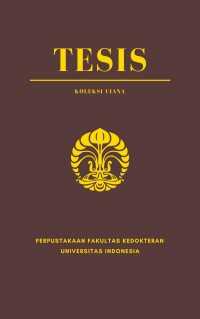Tesis
Perbandingan Efektivitas Analgesia Perioperatif antara Blok Thoracolumbal Interfascial Plane dengan Blok Erector Spinae Plane pada Prosedur Dekompresi dan Stabilisasi Posterior Lumbal: Kajian Skala Nyeri, Konsumsi Total Opioid, Kestabilan Kardiovaskular, Kadar Il-6 dan Il-10 Perioperatif = The Comparison Effectiveness of Perioperative Analgesia between Thoracolumbar Interfascial Plane Block and Erector Spinae Plane Block in Decompression and Posterior Lumbar Stabilization Procedures: Study of Pain Scale, Total Opioid Consumption, Cardiovascular Stability, Perioperative Il-6 and Il-10 Levels.
Latar Belakang: Prosedur dekompresi dan stabilisasi posterior lumbal berhubungan dengan nyeri hebat pascabedah dan menghasilkan respon stress pembedahan. Blok ESP dan blok TLIP efektif sebagai analgesia perioperatif pada prosedur pembedahan tulang belakang. Penatalaksanaan nyeri pascabedah yang adekuat dapat mengurangi respon stres yang timbul akibat pembedahan. Tujuan: Membandingkan efektifitas antara blok ESP dan Blok TLIP sebagai analgesia perioperatif pada prosedur dekompresi dan stabilisasi posterior lumbal terhadap skala nyeri, konsumsi total opioid, kestabilan kardiovaskular, kadar IL-6 dan IL-10 perioperatif. Metode: Penelitian ini merupakan penelitian eksperimental, uji klinis acak tersamar ganda terhadap 40 subjek yang menjalani pembedahan dekompresi dan stabilisasi posterior lumbal di Instalasi Bedah Pusat RSUPN Dr. Cipto Mangunkusumo Jakarta dan RSUD dr Zainoel Abidin Banda Aceh. Subjek dirandomisasi dalam dua kelompok: kelompok blok ESP (n=20) dan kelompok blok TLIP (n=20). Kedua kelompok mendapat bupivakain 0,25% total volume 20 cc setiap sisi. Data yang diolah berupa skala nyeri NRS (Numerical rating scale) pada 1, 6, 12, 24 jam pascabedah, konsumsi morfin dalam 24 jam, jumlah fentanyl intraoperatif, waktu pemberian morfin pertama pascabedah, konsentrasi IL-6 dan IL-10 perioperatif. Analisis data menggunakan Uji t berpasangan dan Mann-Whitney. Hasil: NRS pada 1, 6, 12, 24 jam pascabedah, konsumsi morfin dalam 24 jam, jumlah fentanyl intraoperatif, konsentrasi IL-6 dan IL-10 perioperatif tidak berbeda bermakna antra blok TLIP dan blok ESP (p > 0,05). Waktu pemberian morfin pertama blok TLIP lebih lama bermakna daripada blok ESP (p=0,002). Simpulan: Keefektifan blok TLIP tidak berbeda dengan blok ESP sebagai analgesia perioperatif pada prosedur dekompresi dan stabilisasi posterior lumbal.
Kata Kunci: Blok TLIP, blok ESP, blok Thoracolumbar interfascial plane, blok Erector spinae plane, pembedahan lumbar tulang belakang, dekompresi dan stabilisasi posterior.
Background: Posterior lumbar decompression and stabilization procedures are related with severe postoperative pain and produce a surgical stress response. ESP block and TLIP block are as effective as perioperative analgesia in spinal surgery procedures. Adequate postoperative pain management can reduce stress response caused by surgery. Objective: To compare the effectiveness of ESP block and TLIP block as perioperative analgesia in posterior lumbar decompression and stabilization procedures and associated pain scale, total opioid consumption, cardiovascular stability, perioperative IL-6 and IL-10 consentrations. Methods: This study was an experimental, double-blind, randomized controlled trial of 40 subjects who underwent decompression surgery and posterior lumbar stabilization at the Central Surgical Unit of RSUPN Dr. Cipto Mangunkusumo Jakarta and RSUD Dr Zainoel Abidin Banda Aceh. Subjects were randomized into two groups: the ESP block group (n=20) and the TLIP block group (n=20). Both groups received 0.25% bupivacaine with a total volume of 20 cc each side. The data were processed in the form of NRS pain scale (Numerical rating scale) at 1, 6, 12, 24 hours postoperatively, morphine consumption within 24 hours, amount of intraoperative fentanyl, time of first postoperative morphine administration, perioperative IL-6 and IL-10 concentrations. Data analysis used paired t test and Mann-Whitney. Results: NRS at 1, 6, 12, 24 hours postoperatively, morphine consumption within 24 hours, amount of intraoperative fentanyl, perioperative IL-6 and IL-10 concentrations were not significantly different between TLIP block and ESP block (p > 0.05). The time of administering the first morphine on TLIP block was significantly longer than ESP block (p=0.002). Conclusion: The effectiveness of the TLIP block is no different from the ESP block as perioperative analgesia in decompression and posterior lumbar stabilization procedures.
Keywords: TLIP block, ESP block, Thoracolumbar interfascial plane block, Erector spinae plane block, lumbar spine surgery, decompression and posterior stabilization.
- Judul Seri
-
-
- Tahun Terbit
-
2022
- Pengarang
-
Rahmi - Nama Orang
Aida Rosita Tantri - Nama Orang
PRYAMBODHO - Nama Orang
RAHYUSSALIM - Nama Orang
Arif H.M. Marsaban - Nama Orang
Darto Satoto - Nama Orang - No. Panggil
-
T22119fk
- Penerbit
- Jakarta : Sp-2 Anestesiologi dan Terapi Intensif., 2022
- Deskripsi Fisik
-
xvi, 89 hlm. ; 21 x 30 cm
- Bahasa
-
Indonesia
- ISBN/ISSN
-
-
- Klasifikasi
-
NONE
- Edisi
-
-
- Subjek
- Info Detail Spesifik
-
Tanpa Hardcopy
| T22119fk | T22119fk | Perpustakaan FKUI | Tersedia |


Masuk ke area anggota untuk memberikan review tentang koleksi